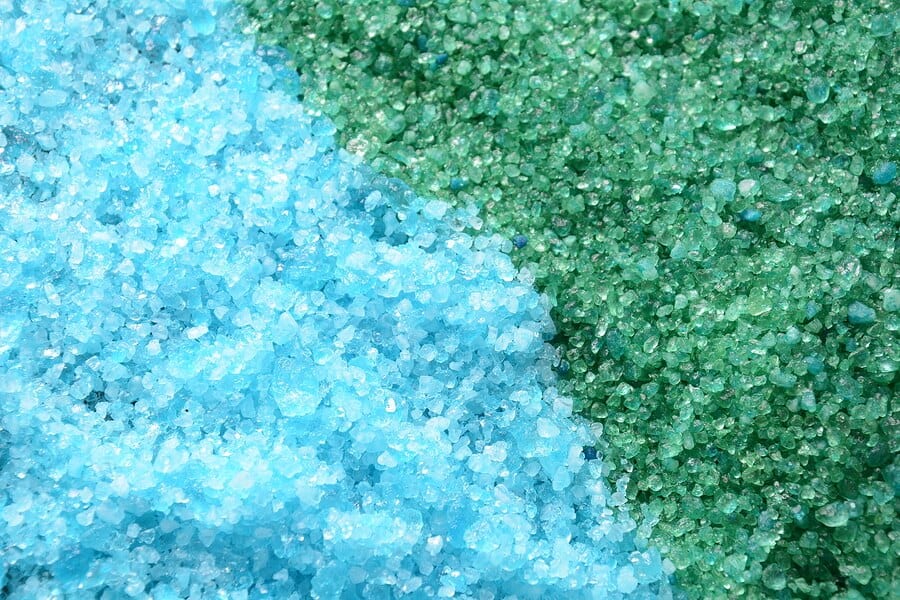
Synthetic cathinones (also more commonly known as bath salts) are man-made stimulants structurally related to cathinone. Cathinones are compounds found in the khat plant native to East Africa and Saudi Arabia.
What Are Synthetic Cathinones?
Traditionally, khat leaves are chewed and induce a mildly stimulating effect. However, synthetic cathinones are often much more potent than their natural form, and in most instances, much more hazardous. Synthetic cathinones are often sold in foil or plastic packages marked as “not for human consumption.” They may be labeled or marked as bath salts, jewelry cleaner, plant food, or any number of products. While synthetic cathinones are most often referred to as “bath salts,” the National Institute on Drug Abuse (NIDA) has stressed that such a reference is in name only. They should never be compared to legitimate bathing products, such as Epsom salts, which do not induce mind-altering effects. Moreover, synthetic cathinones have no real use for bathing and are solely used for recreational drug use, as a less expensive substitute for other stimulant drugs, such as cocaine and meth. These drugs can often be found online, behind the counter in convenience stores, gas stations, truck stops, and tobacco or “head” shops. Synthetic cathinones are typically sold in 200-500 mg packages under brand names such as Bloom, Vanilla Sky, Red Dove, Snow Day, and many more. Manufacturers label these products as “not for human consumption” in an attempt to evade federal laws which would otherwise impede production. Synthetic cathinones range from a white-brown crystalline powder and can come in the form of a tablet or capsule. They are typically ingested orally, but can also be crushed and smoked, snorted, or injected. The NIDA reports that one of the active ingredients in bath salts MDPV is at least ten times more potent than cocaine. Along with mephedrone, it is commonly found in the blood and urine of patients admitted to the emergency department after having consumed bath salts.
Abuse And Effects
Due to its stimulant-like effects, synthetic cathinones may be abused by individuals across all demographics, looking for a new high. Use of these drugs occurs despite substantial dangers and unpredictable, adverse outcomes. The use of bath salts was at its worst around 2011, and due to high rates of abuse and adverse consequences, Congress responded by passing the Synthetic Drug Abuse Prevention Act of 2012. Currently, only MDPV and mephedrone are permanently outlawed chemicals. Although this law is helpful, manufacturers continue to substitute chemicals that are comparable, unregulated, and uncontrolled. Many people who abuse bath salts choose to do so because they can still be easily purchased through a number of avenues. Also, synthetic cathinones are generally much stronger than many the stimulant drugs they are intended to mimic, such as cocaine. Despite extremely hazardous effects, new laws, and warnings from federal agencies such as NIDA and the Drug Enforcement Administration, abuse of bath salts has endured since 2011. As noted, makers of these drugs circumvent legal ramifications by slightly altering their chemical composition. They then continue to market synthetic cathinones as any number of different products, all of which are labeled as “not for human consumption.”
Again, cathinones are stimulants designed to simulate the effects of other drugs such as cocaine and meth. Moreso than even these substances, however, synthetic cathinones have extremely unpredictable and bizarre effects on users. In many cases, the use of these substances results in violent, erratic, and even psychotic behaviors. Effects of synthetic cathinones may include the following:
- Increased sociability
- Talkativeness
- Anxiety
- Panic attacks
- Severe paranoia
- Visual hallucinations
- Tactile hallucinations
- Increased libido
- Delirium
- Aggression and violence
- Extreme agitation
- Increased heart rate
- Chest pain
- Seizures
- Elevated blood pressure
Reports have revealed that some of the worst outcomes are related to snorting or injecting synthetic cathinones, and in some cases, death has subsequently occurred. There have also been many reports of people who have exhibited psychosis and attempted or committed suicide or homicide following the consumption of excessive amounts of synthetic cathinones. Many reports have noted bizarre and harmful behavior from those who have become intoxicated by synthetic cathinones. Federal laws have banned the manufacture, sale, and use of bath salts of all forms. However, those who seek to use it may be still able to find these drugs in gas stations, head shops, and the like.
Are Synthetic Cathinones Addictive?
They are considered to have a high potential for abuse and addiction. However, there is scant research investigating whether or not they exhibit the same type of addictive qualities as other illicit drugs such as heroin, meth, or cocaine. Despite a lack of evidence of their potential for addiction, many have reported suffering from some level of withdrawal and drug cravings when they try to quit using synthetic cathinones. Synthetic cathinones may produce withdrawal symptoms that include the following:
- Anxiety and depression
- Tremors
- Insomnia
- Paranoia
There is not enough evidence to determine a distinct timeline of withdrawal associated with synthetic cathinones. It should be noted that there are no reports of the symptoms of withdrawal being life-threatening. That said, there can be a wide variety of toxic ingredients in bath salts. Therefore, there can be no guarantee that detox from these substances will not become dangerous. Also, synthetic cathinones are sometimes mixed together with other substances that may be addictive and dangerous. For example, sources have reported that Molly (MDMA) capsules may contain synthetic cathinones.

Getting Help
Recovery can be effectively accomplished through psychotherapy and counseling in an intensive addiction treatment program. Most people who abuse synthetic cathinones are also poly-substance abusers, meaning that they abuse or are addicted to more than one substance. To recover from an addiction to synthetic cathinones or any substance, individuals must address the underlying causes of substance abuse through intensive behavioral therapy and counseling. One of the main benefits of a treatment program is to adjust one’s life and behaviors and alter them to be more conducive to a healthy and productive lifestyle. This lifestyle must be one that does not include drug or alcohol abuse of any kind. Moreover, the purpose of addiction treatment is not merely to be free from the abuse of a drug or substance. It is also to learn coping skills and how to live a healthier and more fulfilling life without engaging in destructive behaviors to handle stress. Harmony Recovery Center works to customize recovery plans for each individual. We understand that everyone is unique, and the road to recovery is simply not going to be the same for everyone. Are you or a loved one addicted to synthetic cathinones or other substances and motivated to make a change toward recovery? If so, please contact us today to speak with one of our caring addiction counselors. We can help you reclaim your life and sustain long-term wellness and recovery!